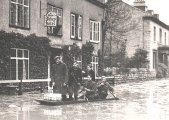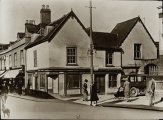Bedford
Victorian Super Sleuth Trail for Children
Places > Bedford > Victorian Super Sleuth Trail > Quiz 1 > Bedford Street Names
Bedford Street Names
Over the centuries, many of Bedford's streets were known by more than one name.
It was only in the 19th century, just before Victoria became queen in 1837, that the 1835 Improvement Commission began
selecting official names for
Bedford's roads.
|
Dame Alice Street Its earliest recorded name was Marston's Lane and it was later called Bendhouse Lane (probably because of connections with the tanning industry in Bedford). In the end, the 1835 Improvement Commission decided on Dame Alice Street - named after Dame Alice Harpur, the wife of Sir William Harpur. They chose this name because The Harpur Trust (now the Bedford Charity) had built almshouses there in the 19th century. |
 |
|
Cardington Road Originally it had a very different name - Potter Street. It's likely that there was a pottery in that area from about the thirteenth century. Sometime after 1877 it became Cardington Road. |
 |
|
Silver Street This street has had more than one name. Originally called Well Street, it was later called Silver Street or Gaol Lane (because the county gaol was sited at the High Street end). Silver Street appears for the first time on John Speed's map of 1610. |
 |
|
Midland Road The Midland Railway opened in 1857 and gave its name to Midland Road. However until 1884 there was confusion about the name of the road that stretched between Harpur Street and the station because it was also known as Well Street. |
|
|
Cauldwell Street Cauldwella (literally meaning cold spring) was an area near Bedford. This became the site of an Augustinian priory, known to be in existence by 1153 - Cauldwell Priory. Cauldwell Street was named after the priory. |
|
|
Foster Hill Road In the 18th century, this road was named Little Berry Lane. But during the 19th century it had two changes of name - Waterloo Road and then Cemetery Road - before becoming Foster Hill Road in 1890. It is said that Cemetery Road was not felt to be a suitable name for a street in a fashionable area. |
 |
Information from Alan Crawley and Ian Freeman. Bedford's Oldest Streets Parts 1 and 2. Bedfordshire Archaeology vol.18 pp.99-108 and vol.19 pp.30-39
Page last updated: 22nd January 2014
